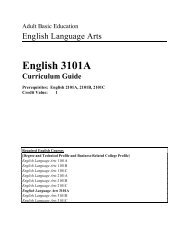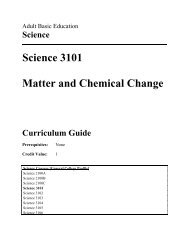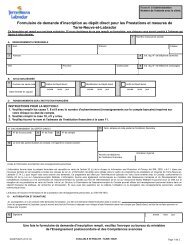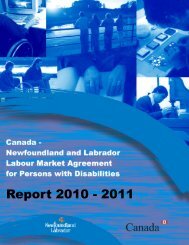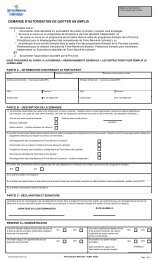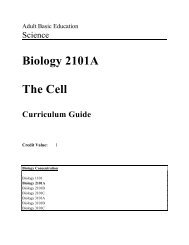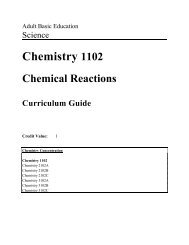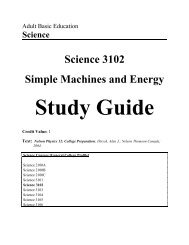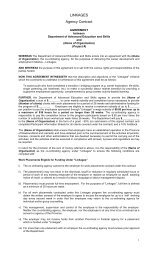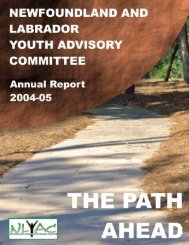- Page 1:
Adult Basic Education Level III Pro
- Page 4 and 5:
MATHEMATICS Introduction...........
- Page 7 and 8:
FOREWORD ABE Level III Curriculum B
- Page 9:
Basic Education program. In October
- Page 12 and 13:
Chairperson: Roberta Yetman, ABE, A
- Page 14 and 15:
Mathematics Chairperson: Cyril Orga
- Page 16 and 17:
ABE Framework The revised ABE progr
- Page 18 and 19:
USING THIS GUIDE ABE Level III Curr
- Page 20:
encompasses and integrates the form
- Page 25 and 26:
Level III Communication Skills Intr
- Page 27 and 28:
IC 3211 Basic Grammar Recommendatio
- Page 29 and 30:
12. Phrases 12.1 Identify and use k
- Page 31 and 32:
IC 3112 Writing Skills Recommendati
- Page 33 and 34:
IC 3113 Evaluative Comprehension Re
- Page 35 and 36:
IC 3214 A/B Oral Communications Rec
- Page 37:
Potential Resources Please refer to
- Page 40 and 41:
5. Further Writing 5.1 Write final
- Page 42 and 43:
Potential Resources Please refer to
- Page 44 and 45:
5. Technical Writing 5.1 Explain im
- Page 47 and 48:
IC 3218 A/B Introduction to Literat
- Page 49 and 50:
Potential Resources Please refer to
- Page 51 and 52:
4.3 Examine literary devices used i
- Page 53 and 54:
3.3 Interpret themes of these selec
- Page 56 and 57:
IC 3321 Optional Literature Recomme
- Page 58:
Potential Resources Please refer to
- Page 61 and 62:
Better Business Writing (Revised Ed
- Page 63 and 64:
Landings: Newfoundland and Labrador
- Page 65 and 66:
Teaching Guide: 0590314548 Printmas
- Page 68:
Employability Skills
- Page 72 and 73:
IE 3211 Consumer Studies 1. Consume
- Page 74 and 75:
IE 3212 Computer Studies Recommenda
- Page 76:
7.8 Sort records in database. 7.9 E
- Page 79 and 80:
4.1 List steps in making decisions.
- Page 81 and 82:
Films and videos: Career Support Se
- Page 83 and 84:
3.4 Apply listening skills (eg. fol
- Page 85 and 86:
National Film Board You're Eating F
- Page 87 and 88:
teacher's guide as follows: Career
- Page 89 and 90:
Small inexpensive booklet prepared
- Page 91 and 92:
Distributing Centre. Small inexpens
- Page 94:
General Options
- Page 97 and 98:
IG 3211 Newfoundland and Labrador C
- Page 99:
Potential Resources Please refer to
- Page 102 and 103:
Potential References Please refer t
- Page 104 and 105:
Potential Resources Please refer to
- Page 106 and 107:
5.1 Report upon a contemporary issu
- Page 108 and 109:
5.5 Describe use of new and unusual
- Page 110 and 111:
4 short films about women recoverin
- Page 112 and 113:
4. Women in the Workforce 4.1 Descr
- Page 114 and 115:
VHS 193 013 Working Mothers Series
- Page 116 and 117:
5.1 Summarize plan for recovery fol
- Page 119 and 120:
IG 3119 Canadian Law 1. Meaning, Fu
- Page 121 and 122:
IG 3120 Democracy 1. Basic Concepts
- Page 123 and 124:
IG 3221 Human Geography 1. Basic Ge
- Page 125:
Potential Resources Please refer to
- Page 128 and 129:
teacher's guide as follows: Career
- Page 130 and 131:
Small inexpensive booklet prepared
- Page 132 and 133:
Distributing Centre. Small inexpens
- Page 135:
Mathematics
- Page 138 and 139:
Gopher features an On-Line Educatio
- Page 140 and 141:
Algebra I Algebra II Algebra III Al
- Page 143 and 144:
IM 3101 Algebra Readiness Recommend
- Page 145:
IM 3102 Geometry Readiness Recommen
- Page 148 and 149:
Potential Resources Please refer to
- Page 150 and 151:
Please refer to the annotated bibli
- Page 152 and 153:
Potential Resources Please refer to
- Page 155 and 156: IM 3207 Business Mathematics II 1.
- Page 157 and 158: IM 3208 Statistics 1. Initial Conce
- Page 159 and 160: IM 3109 Algebra I 1. Real Number Sy
- Page 161 and 162: IM 3210 Algebra II 1. Linear Senten
- Page 163 and 164: IM 3211 Algebra III 1. Functions 1.
- Page 165 and 166: IM 3212 Algebra IV 1. Conic Section
- Page 167 and 168: IM 3213 Algebra V 1. Polynomial Fun
- Page 169 and 170: IM 3114 Geometry I 1. Parallel Line
- Page 171 and 172: IM 3115 Geometry II 1. Similarity 1
- Page 173 and 174: IM 3216 Trigonometry 1. Trigonometr
- Page 175 and 176: IM 3217 Advanced Algebra I 1. Real
- Page 177 and 178: IM 3218 Advanced Algebra II 1. Syst
- Page 179 and 180: IM 3219 Advanced Algebra III 1. Pol
- Page 181: Potential Resources Please refer to
- Page 184 and 185: 5. Parallelograms and Trapezoids 5.
- Page 186 and 187: proofs and determining length of va
- Page 188 and 189: Potential Resources Please refer to
- Page 190 and 191: Covers objectives for both options
- Page 192 and 193: following text: College Algebra and
- Page 195: Science
- Page 198 and 199: IH 3120 Electrochemistry Physics IP
- Page 200 and 201: 6. Biological Organization of Livin
- Page 202 and 203: (circulatory) system for one exampl
- Page 206 and 207: 4.1 Define population. 4.2 Identify
- Page 208 and 209: 6.1 Outline composition of DNA and
- Page 210 and 211: Potential Resources Please refer to
- Page 212 and 213: 5.1 List waste products removed by
- Page 215 and 216: IH 3111 Introductory Chemistry 1. C
- Page 217 and 218: IH 3112 Chemical Language Prerequis
- Page 219 and 220: IH 3113 Reactions and Equations Pre
- Page 221 and 222: IH 3114 The Mole and Stoichiometry
- Page 223 and 224: IH 3215 Chemical Bonding Prerequisi
- Page 225: Potential Resources Please refer to
- Page 228 and 229: Potential Resources Please refer to
- Page 230 and 231: Potential Resources Please refer to
- Page 232 and 233: Potential Resources Please refer to
- Page 234 and 235: Potential Resources Please refer to
- Page 236 and 237: Potential Resources Please refer to
- Page 238 and 239: Potential Resources Please refer to
- Page 240 and 241: Potential Resources Please refer to
- Page 242 and 243: 4.1 Describe colour, or visible lig
- Page 245 and 246: IP 3214 Fluids and Heat 1. Fluids 1
- Page 247: Potential Resources Please refer to
- Page 250 and 251: Potential Resources Please refer to
- Page 252 and 253: 4. Energy 4.1 Distinguish between w
- Page 255 and 256:
IS 3211 Oceanography 1. Properties
- Page 257:
Potential Resources Please refer to
- Page 260 and 261:
4. Earth History 4.1 Outline geolog
- Page 263 and 264:
IS 3213 Physical Science 1. Measure
- Page 265:
Potential Resources Please refer to
- Page 268 and 269:
3.5 Choose five issues which may in
- Page 271 and 272:
IS 3215 Life Science Learners may c
- Page 273 and 274:
7. Diseases 7.1 Define disease. 7.2
- Page 275 and 276:
Level III Science Annotated Bibliog
- Page 277 and 278:
Chemistry at Work. Brenda Shapiroo
- Page 279 and 280:
Life Worldwide. T. Carrick. (1986)
- Page 281 and 282:
This company may carry a variety of
- Page 283 and 284:
Career Institute 423 Cardinal Drive
- Page 285 and 286:
Fisher Scientific Company Ltd. 18 M
- Page 287 and 288:
Learning Resources Distribution Cen
- Page 289 and 290:
Ontario Institute for Studies in Ed
- Page 291 and 292:
University Associates of Canada, In
- Page 293 and 294:
St. John's, NF A1B 4J6 Telephone: 7
- Page 295:
Appendix A
- Page 299:
Appendix B
- Page 303:
Appendix C
- Page 306:
282 ABE Level III Curriculum Date
- Page 310:
ABE LEVEL III COURSE COMPARISON MAT
- Page 315 and 316:
ABE LEVEL III GENERAL OPTIONS COURS
- Page 317 and 318:
ABE LEVEL III COMMUNICATIONS SKILLS
- Page 319 and 320:
ABE LEVEL III SCIENCE COURSE COMPAR
- Page 321 and 322:
ABE LEVEL III MATHEMATICS COURSE CO
- Page 323 and 324:
ABE LEVEL III EMPLOYABILITY SKILLS




